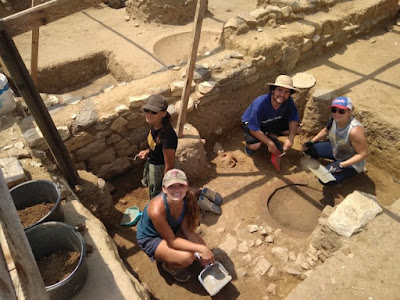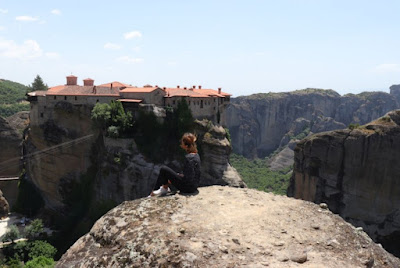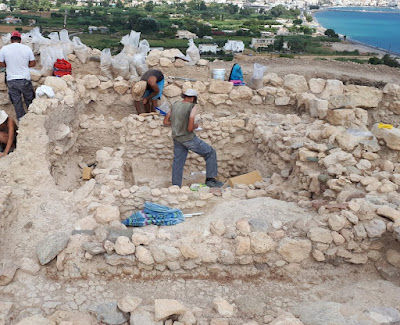Field archaeologists and classics scholars are using digital technologies in diverse ways that are transforming investigations of the ancient world. At ancient Eleon in central Greece, our project is a collaboration of the Ephorate of Antiquities of Boeotia, the University of Victoria, and Wellesley College. Our project has embraced digital archaeology as a guiding principle for our recording of excavation progress, analysis of finds, documentation of contexts, and presenting the site in new and exciting ways.
Our digital project began in 2015, when Jordan Tynes, Wellesley College, began supervision of our drone-based photography to create a digital model of the site’s topography and major architectural remains, including Eleon’s Late Archaic polygonal wall and Medieval tower. [Above, Jordan Tynes launches a drone on site (left), and scans an Eleon artifact in the Thebes Archaeological Museum with the assistance of conservator Sophia Michailoglou (right).] We were excited, from the beginning, by how the Pix4D combined images to create both 2D photo-mosaics of high resolution and 3D models of great accuracy. [Below, a comparison of an aerial photo of the polygonal wall at Eleon (left) with the rendering of a 3D photogrammetric model.]
With additional support for equipment and student-training from
Wellesley College’s Friends of the Library, we developed a protocol to
track excavation results with daily drone flights and more detailed
photogrammetry of select trenches. Using an Artec Spider hand-held
scanner we began to create digital models of artifacts, accurate to 0.5
mm. Fortunately, this work coincided with our focus on the burials of
the Blue Stone Structure, producing highly detailed models for the Early
Mycenaean tombs, their contents, and the surrounding architecture [seen below].
Back at Wellesley’s Knapp Center, we have created a Virtual Reality experience that offers a high quality simulation of the excavated remains within the Unity game engine. A preliminary version of this interactive model presents the tombs as they were revealed at the end of the 2016 excavation season (link to video). We are now working on a version that uses data from the fully uncovered Blue Stone Structure, including important tombs just beyond the enclosure. Wearing a headset and navigating with gaming controllers, users are able to traverse the tomb architecture, read labels about the excavation results, and manipulate select artifacts that are placed on a virtual table beside the excavation trenches [Below, an Early Mycenaean brichrome jug as represented through digital scanning (left) and controlled within the VR environment by Wellesley student Kate Hall (right)].
This past season, a team of digital archaeology students collected new imagery of architecture and artifacts to ensure that the model incorporatescomplete and consistent information. We also had the pleasure of sharing the Virtual Reality prototype with our full excavation team in Greece, gathering feedback from those who know the site best! [Below Brendan Burke (left) and Janelle Sadarananda (right) evaluate Virtual Eleon, with Jordan Tynes and Nefeli Theocharou observing.]
The field of archaeology will continue to develop new and exciting applications from the Digital Humanities. We’re proud that our research team at ancient Eleon works at the forefront of these research methodologies, and we hope to continue to do so in the years to come.
A selection of 3D models and a video of user interaction within our prototype environment can be viewed at the excavation project website: https://ebapexcavations.org/digital
Bryan Burns & Brendan Burke
Wellesley College & University of Victoria; co-directors of Eleon Excavations






































